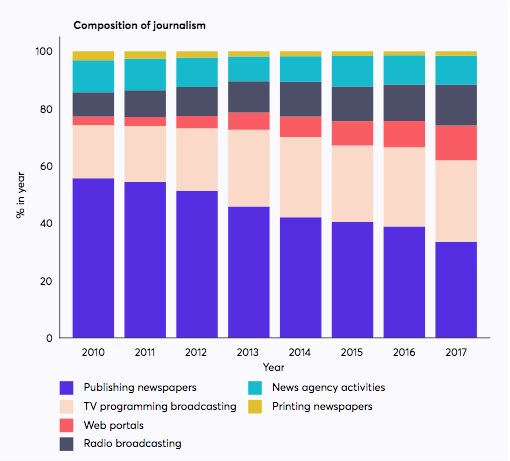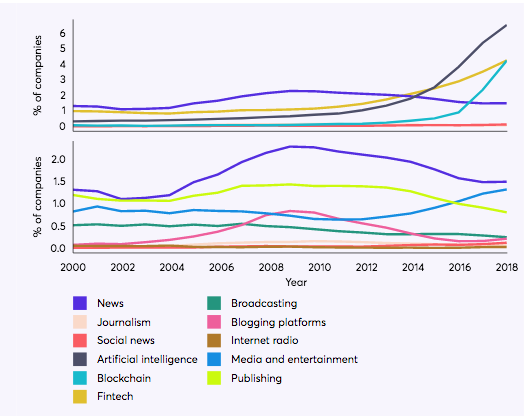
UK public interest news lacks funding opportunities and geographical diversity, according to new research following the recommendations of the Cairncross Review into sustainable journalism.
Coming out of the review, innovation foundation Nesta was selected to run the Future News Fund to stimulate new business models in local news. As part of that commitment, Nesta released a study earlier this month to assess the landscape for the pilot fund.
The research report, 'Mapping the news, media and journalism landscape', looks into employment trends, startup shifts, philanthropic and non-profit support, the scope of misinformation and evolution of public interest news.
It brings together for the first time public and private databases (Business Register Employment Survey, Public Health England, Crunchbase, 360Giving, Candid, Microsoft Academic) to offer a more comprehensive insight into public interest news activity. However, the study highlights considerable limitations due to data gaps (lower than company average available data from Crunchbase and 360Giving), hence its recommendations for further research.
It reveals that more than half (57 per cent) of newspaper jobs are squeezed into just 10 Local Authority Districts (of which there are more than 300 in the UK). This means they are four times more concentrated than any other industry.
The number of people working in journalism-related industries has remained stagnant (at 85,000) since 2011, but the composition has changed considerably. Web portal jobs in the sector have increased in the wake of declining newspaper jobs.

Screenshot Nesta: 'Mapping the news, media and journalism landscape',
The UK philanthropic funding landscape for media organisations is also dominated by a small number of actors, with nearly three-quarters (73 per cent) of the UK funding coming from its top three funders. The median grant size of funds in the UK is 41 per cent lower than in the United States.
Journalism and news are also one of many traditional sectors growing more slowly than, and losing market share of investment to, younger but rapidly growing sectors such as AI, blockchain and fintech.

Screenshot Nesta: Mapping the news, media and journalism landscape'
Funding for news and journalism companies has ranged from as little as $5,000 to as high as $80 million, but the average investment is lower than other countries with a similar socio-economic profile.
It paints a bleak picture. In an e-mail to Journalism.co.uk, Anna Hamilos, senior programme manager, Future News Fund said that the findings would have represented a perilous position for local news companies even before the added strain of covid-19. Many of their current grantees have since furloughed staff while maintaining usual news operations.
She stressed that the findings have shown that more diverse funding is needed for media organisations and innovation.
"The industry in the UK needs more support and incentives from the government, investors and philanthropic funders. Our research shows that this is possible and that the UK is lagging behind," she writes.
"We’re also yet to see allocated large-scale emergency support for the media sector from the government or the philanthropic sector be able to fill that gap. Emergency relief from the Google News Initiative and the Facebook Journalism Project, and on a much smaller scale, the Public Interest News Foundation, are going to go some way in helping but we do need a longterm plan for supporting the public interest news sector."
Allowed to continue at this rate, Hamilos added that 'news deserts' (areas without any local media coverage) and 'ghost newspapers' (newspapers reliant on unoriginal content) are strong possibilities.
"With the geographical concentration already being very high for the sector, we could be in a position where local areas are no longer served by news that is rooted in their community and we could see the further alienation of communities who need strong public sector news."
Nesta is planning to release a second report in August 2020 with policy recommendations for public interest news outlets struggling in covid-19 times.
For now, the report has helped shape support needed for their first grantees who were selected for being hyperlocal news outlets, including The Manchester Meteor, The Bristol Cable, New Internationalist as well as grantees such as Black Ballad and Tortoise Local that aimed to expand their service or membership regionally.
Do you want to become a successful freelancer? Learn new skills and get a certificate in freelance feature writing, pitching, copywriting, sub-editing and more. Click here for more information
Free daily newsletter
If you like our news and feature articles, you can sign up to receive our free daily (Mon-Fri) email newsletter (mobile friendly).
Related articles
- Protecting independent journalism, with Lexie Kirkconnell-Kawana of IMPRESS
- Five key takeaways from the UK select committee on the future of news
- The first UK local news publisher gains charitable status
- New app uses geolocation to help local publishers boost ad revenue
- How MyLocal Lincolnshire and Ping! are innovating local media









